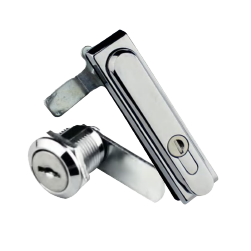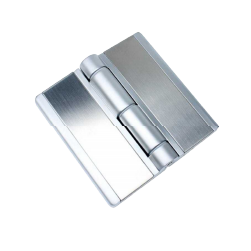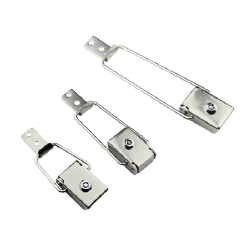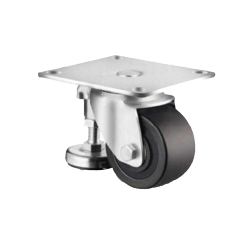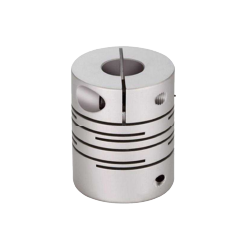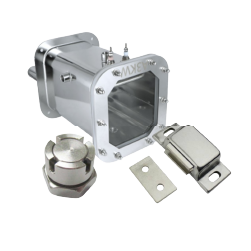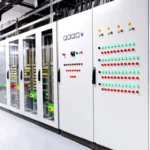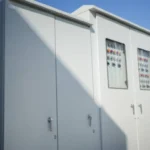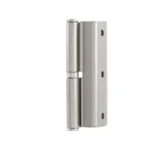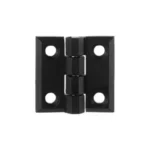Introduction
The electrical panel locks are the basic elements of the huge structure of industrial and commercial safety. They are not mere hardware, but the first line of defense against unauthorized access, environmental hazards, and catastrophic operational failures, and are the main gatekeepers to critical electrical systems. The choice of a proper lock is not a trifling matter; it is a well-thought-out decision that directly affects the safety of personnel, the integrity of equipment, and compliance with regulations. This paper gives a detailed analysis of electrical panel locks, including their varieties, key security aspects, and a logical structure of selecting the right solution to any particular application.
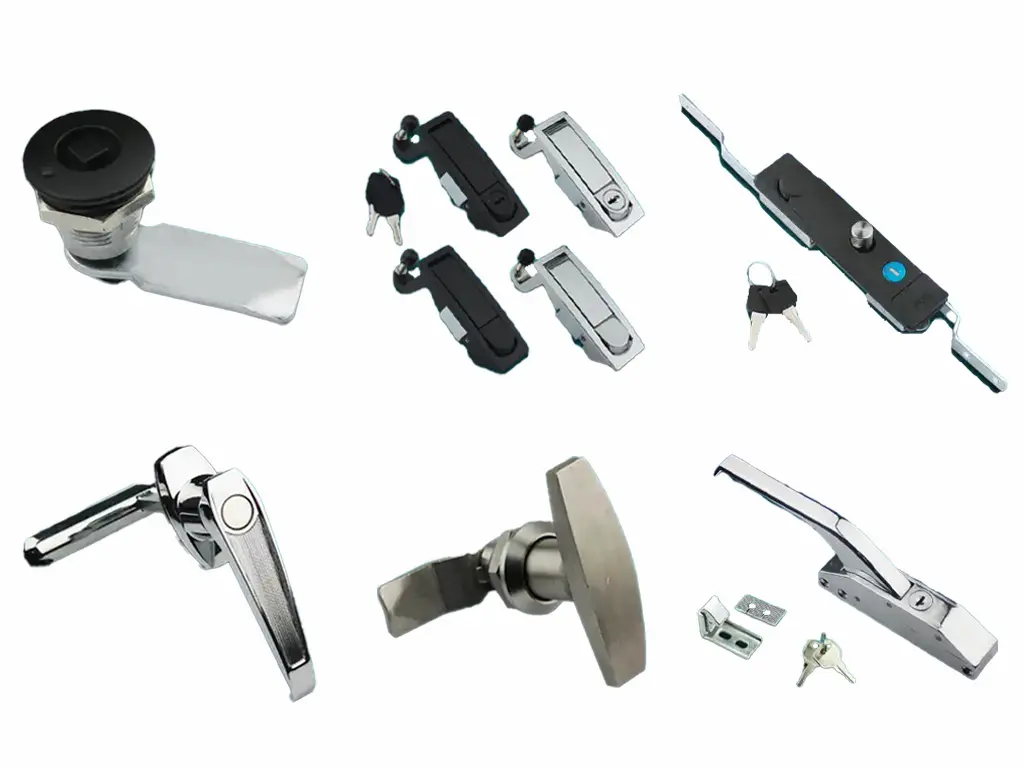
What Are Electrical Panel Locks and Why Do They Matter?
An electrical panel lock is a mechanical or electronic lock used to lock the access door or cover of an electrical enclosure, switchgear cabinet, or distribution board. It does not only serve to prevent entry. These locks are part and parcel of the overall safety and operational plan of a facility due to a number of reasons that are very crucial.
The first is the safety of personnel. Free access to live electrical parts is a serious threat to electrocution, arc flash accidents, and other injuries that can cause death. An installed lock will make sure that only trained and authorized people can enter these dangerous places, which will greatly reduce the risk of accidents. This includes preventing accidental contact with a live breaker.
Second, they safeguard the equipment itself. Electrical systems are vulnerable to contaminants such as dust, moisture and corrosive substances, and physical interference. A lock that is secure and well sealed will keep out the harmful elements and internal components are not vandalized or unauthorizedly changed, which may result in equipment failure and expensive downtime.
Third, these locks form the basis of regulatory compliance. In most jurisdictions, regulations established by organizations such as the Occupational Safety and Health Administration (OSHA) require certain steps to be followed in the process of controlling hazardous energy. An example is the Lockout/Tagout (LOTO) procedures that cannot be effectively applied without trustworthy locking devices. Non-compliance may lead to serious punishment, legal responsibility, and a weakened safety culture in the workplace. Essentially, an electrical panel lock is not a component, but a key facilitator of safe and secure operating environment.
Common Types of Electrical Panel Locks Explained
The market provides a great variety of locking solutions, which are designed to meet various needs of security, access frequency, and environmental conditions. The initial step in making an informed choice is to understand the differences between these types. They can be classified into mechanical and electronic locks.
| Lock Type | Key Features | Best Applications | Security Level |
| Cam Lock | Simple design, compact size, easy to install | Small/medium enclosures, control boxes | Low |
| Compression Latch | Sealed closure, vibration resistance | Outdoor enclosures, industrial machinery | Medium |
| Handle Lock | Ergonomic, suitable for heavy doors | Large cabinets, server racks | Medium-High |
| Multi-Point Lock | Secures multiple points simultaneously | Tall/large enclosures, telecom cabinets | High |
| Quarter-Turn Latch | Quick access with simple tool | Junction boxes, low-security panels | Low |
| Electronic & Smart Lock | Keypad, RFID, audit trail, remote control | High-security, compliance-critical panels | Very High |
Mechanical Locks
The most common type is mechanical locks that use physical keys and mechanisms to offer security. They are appreciated due to their reliability, durability and cost-effectiveness in many standard applications.
Cam Locks
One of the most popular and straightforward panel locks is a cam lock. It is designed with a cylindrical body, a core that is operated by a key, and a flat metal arm, or cam, that turns when the key is turned. The cam swings behind the panel frame when the door is in the locked position. They are simple, small, and easy to install, which makes them suitable in small to medium-sized enclosures, access panels, and control boxes where high security is not the main priority. Cam locks come in many variations, such as varying lengths to fit different thicknesses of doors and frames, and may be keyed alike (all locks open with the same key), keyed differently (each lock has a different key), or master keyed.
Compression Latches
The compression latches have a unique benefit compared to the conventional locks because they offer a tight and sealed closure. These latches, when actuated, initially latch onto the frame and then, in a second movement, draw the door firmly against a gasket. This compression action gives them great protection against ingress of dust and water and are therefore suitable in applications where a high IP or NEMA rating is required. Moreover, the pressure is constant and it helps to remove rattles and vibrations, which is an essential characteristic of enclosures that are mounted on moving vehicles or heavy machinery. They are favored in outdoor enclosures, industrial control cabinets, and any application where environmental sealing and vibration resistance is of primary concern.
Handle Locks
Handle locks, L-handles and T-handles, are used on larger, heavier electrical cabinet doors that need more leverage to open. These locks integrate a handle into the locking mechanism itself. The handle is turned and the internal latching cam is retracted, and the handle is used to pull the heavy door open. They provide an ergonomic solution and are commonly used on large multi-bay electrical enclosures and data center server racks. Many handle locks can be supplied with a range of locking cores, including basic key locks, and high security cylinders, and can also be supplied without a locking action where only latching is required.
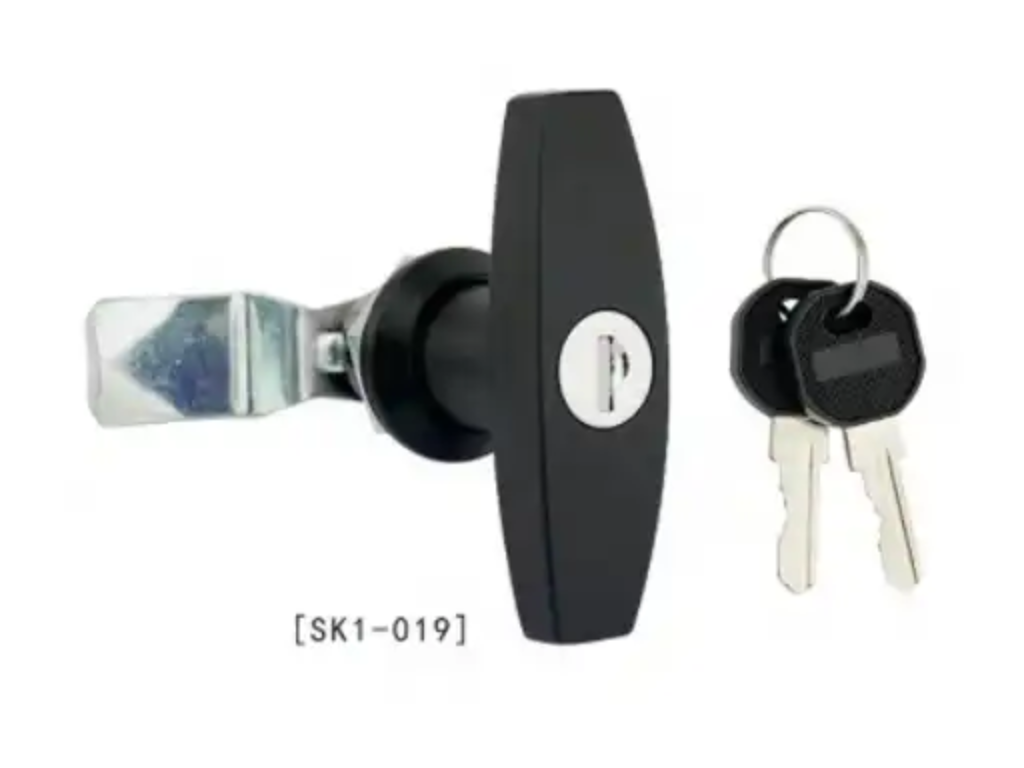
Multi-Point Locks
A single-point lock might not be secure or seal well on very large or tall enclosure doors that are prone to warping. This issue is addressed by multi-point locking systems, which lock the door at two, three or more points at once by turning a single key or handle. They are operated by a set of connecting rods to operate latches at the top, bottom, and center of the door edge. This will keep the door firmly against the frame throughout its length, giving better security against forced entry and preserving the integrity of the environmental seal. They are typical of industrial control panels and telecommunications cabinets.
Quarter-Turn Latches
Quarter-turn latches, as the name implies, lock a door by turning the actuator 90 degrees. They are fast and convenient and are ideal in enclosures where there is frequent but controlled access, e.g., small junction boxes or internal access panels. They are usually of a low level of security, designed to keep out accidental opening rather than to keep out determined entry. They are opened with a simple device, a slotted key, or a common triangular or square key used in the electrical trades, which offers a rudimentary form of access control to authorized personnel only, who possess the appropriate tool.
Electronic & Smart Locks
Electronic locks represent a significant technological step up from their mechanical counterparts. They are unlocked by a keypad, an RFID card, or a biometric scanner instead of a conventional key. Smart locks provide an additional functionality, usually with Bluetooth or Wi-Fi connectivity to enable remote access control and monitoring through a smartphone or central computer system. Their main strength is better access control. Administrators can assign or remove access credentials in real-time, establish time-based access privileges, and most importantly, produce an audit trail of all opening and closing activities. This gives a clear log of who has accessed a panel and when, which is invaluable to security management and incident investigation.
Key Security Features to Look for in Electrical Panel Locks
To assess the security of a panel lock, it is not enough to focus on its general type and pay attention to certain design characteristics.
Locking Mechanism Type
One of the main factors that determines the security of the lock cylinder is its internal mechanism. Basic cam locks often use a simple wafer tumbler mechanism, which provides little resistance to picking. To get locks with higher security applications, seek locks with a pin tumbler or disc detainer mechanism. These are much more complicated and offer more resistance to the covert entry methods.
Tamper Resistance
A lock can be as good as its resistance to physical attack. Important tamper resistance characteristics are drill-resistant hardened steel plates in the lock cylinder to thwart drilling attacks, shrouded hasps to prevent bolt cutters’ access to the padlock shackle, and thick-gauge steel or zinc alloy construction to resist prying and brute force.
Key Management Systems
Key management is as important as the lock. In facilities that have many enclosures, a master key system can be used to provide hierarchical access. Each key may unlock a particular lock, whereas a master key may unlock all the locks in a particular group, making access easy for supervisory staff. To ensure the highest level of security, request locks that have restricted keyways, so that locksmiths cannot duplicate keys. Whether to use keyed alike (more convenient but less secure in case of a lost key) or keyed to differ (more secure but more keys to handle) is purely a matter of operational and security procedures of the facility.
Environmental Protection
The lock should be capable of resisting its environment of operation. The level of protection of a lock against intrusion of solids and liquids is quantified by Ingress Protection (IP) ratings, an international standard, and National Electrical Manufacturers Association (NEMA) ratings, which are common in North America. As an example, an IP65-rated lock is fully dust-proof and resistant to low-pressure water jets. A NEMA 4 rating has a comparable degree of water and dust protection. The selection of a lock with the correct rating is essential in outdoor applications, washdown locations, or dusty industrial settings to avoid not only the failure of the lock mechanism but also the introduction of contaminants into the panel.
Material & Durability
The material used in a lock has a direct impact on its durability and its ability to fit in a particular environment. Die-cast zinc alloy is a widely used and economical solution to typical indoor use. In high-humidity environments, where there is chemical exposure or saltwater, stainless steel (usually grades 304 or 316) is a better option because it is highly resistant to corrosion. Brass is also a durable and corrosion-resistant option often used for its aesthetic qualities and longevity. Composite materials and high-impact polymers are also employed which have good durability, corrosion resistance and the added advantage of being lightweight and non-conductive.
Electrical Insulation & Dielectric Safety
The lock itself should not pose an electrical hazard in the case of electrical panels. Certain locks are specifically made with non-conductive materials, like nylon or polyamide, in the handles, bodies or actuation parts. These dielectric characteristics ensure that the lock does not become energized in the event of an internal short circuit, thus personnel are not exposed to electric shock when using the lock. This is a very important safety factor particularly in locks that are mostly metal.
How to Choose the Right Electrical Panel Lock
The choice of the right lock is a methodical process of assessing the needs of the application.
Installation Environment
The first thing to consider is the location of the lock. In indoor, climate-controlled areas, a typical zinc alloy lock can be used. In outdoor applications, a high IP/NEMA rated stainless steel or other corrosion resistant material lock is necessary to avoid seizure and failure due to exposure to rain, sun and temperature extremes. A 316-grade stainless steel lock may be the specification in a very corrosive environment such as a chemical plant or coastal location.
Enclosure Type
The nature of the enclosure door determines the kind of lock required. A lightweight access panel may be fastened with a simple cam lock or a quarter-turn latch. A heavy, full-height or large door will need the leverage of a handle lock and possibly the distributed security of a multi-point system to make sure it closes securely and will not warp with time.
Required Access Control Level
Think about who should have access and how this access should be controlled. A simple keyed lock can be adequate in a panel in a secure, low-traffic area. A panel in a high-traffic or public place will require a stronger, tamper-proof lock. An electronic lock with an audit trail is the better option in case you have to monitor access due to security or compliance requirements. A padlock and hasp system is the norm in LOTO applications.
Compatibility & Installation Factors
The lock should physically match the enclosure. Measure the current mounting hole or cutout size to locate a replacement. Think about the thickness of the door and the grip range of the lock, which is the distance that the lock can handle between the front of the door and the locking surface. In the case of new installations, make sure that you have the right tools to make the necessary cutout.
Budget
Lastly, cost is a practical factor. Although the temptation is to choose the lowest cost option, the price of a lock is insignificant in comparison to the possible cost of an accident, equipment damage or regulatory fine. The budget must be weighed against the necessary degree of security, durability and compliance. Do not just buy the cheapest lock but one that suits the application.
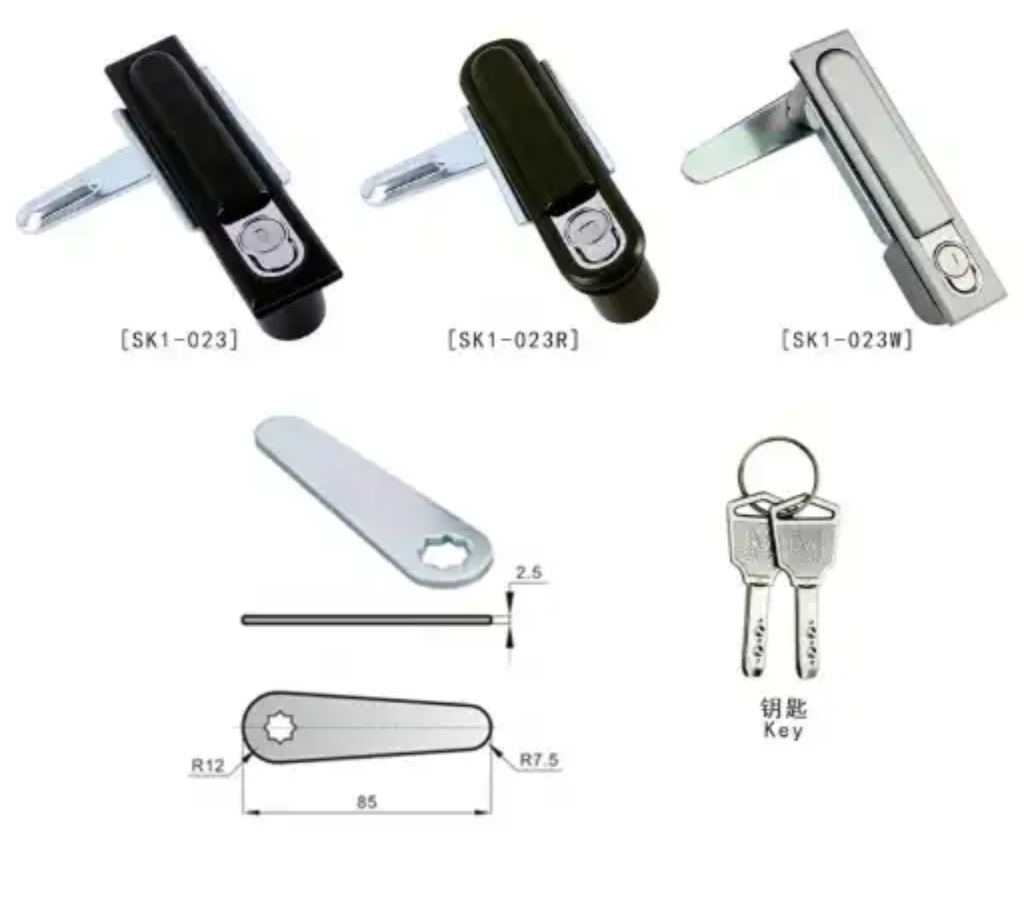
Installation Best Practices & Compliance
Correct installation is as important as correct selection. Never deviate with the installation instructions of the manufacturer. Make sure the lock is properly aligned so that the cam or latch will fit into the frame without binding. Install the given mounting hardware and secure it to the suggested torque to avoid loosening with time as a result of vibration.
Once installed, test the lock. Check that it latches securely, the key operates smoothly, and the door is held firmly closed. In compression latches, ensure that a proper seal is being formed with the gasket.
Compliance-wise, especially in the United States, the lock and its application should be able to support the safety programs of the facility, which are usually regulated by OSHA standards. In the case of service and maintenance work, it implies the application of a locking system that is compatible with the LOTO protocol (OSHA 29 CFR 1910.147). The selected hardware should be substantial in a way that it cannot be removed easily without applying excessive force and it should also be able to identify the installer.
Conclusion
The electrical panel lock is a device of critical importance, serving as a linchpin for safety, security, and operational reliability. Its role is to protect people from harm, equipment from damage, and organizations from the severe consequences of non-compliance. A thorough understanding of the different types available—from simple mechanical cam locks to sophisticated electronic systems—is essential. The selection process must be deliberate, carefully weighing the installation environment, the nature of the enclosure, the required level of access control, and key security features like tamper resistance and material durability. By investing in the right high-quality lock and installing it correctly, a facility reinforces its commitment to a secure and safe working environment.
FAQs
Are electrical panel locks secure?
Electrical panel lock security varies. Basic latches offer minimal security, while high-quality, multi-point locks made of hardened steel provide strong protection. Security depends on the lock type, material, and design, and should be chosen based on risk.
How often should I inspect and maintain my electrical panel locks?
Inspect critical or harsh environment electrical panel locks quarterly. For standard indoor use, semi-annual or annual checks are sufficient. Always check for damage, smooth operation, secure latching, and lubricate if recommended.
Where can I purchase high-quality electrical panel locks?
To purchase high quality electrical panel locks, purchase through industrial suppliers. It is not advisable to use generic locks found in consumer hardware stores in critical industrial or commercial applications since they are not usually up to the standards of durability and security required.
In case you want to find the best locks, one of the best choices is KUNLONG, a company with experience in the production of industrial hardware since 2005. KUNLONG has 20 years of experience in the industry, and it has 12 sectors, and it provides free pre-sales consultation to advise the most appropriate products. We provide custom design services, with over 700 custom functional solutions developed to date, and a selection of 30+ color options, and 10+ surface finishes.
Our locks are constructed to high standards- ISO9001, ROHS, CQC, CE certified, and supported by 108 patents. Every batch is checked 15 times in terms of quality, and it is checked 100 percent. Tolerances are maintained at 0.0005mm, which is much beyond the industry standards. The materials are SGS and ROHS certified and all the components are traceable.
KUNLONG locks are reliable, have high load capacity, corrosion resistance (1,000h salt spray test), and other advanced functions such as anti-bacterial coating, shock resistance, and wide temperature range (-70℃ to 260℃). We are quick to respond to any questions within 12 hours.
Contact us now to get the right locking solution to your industrial requirements.

